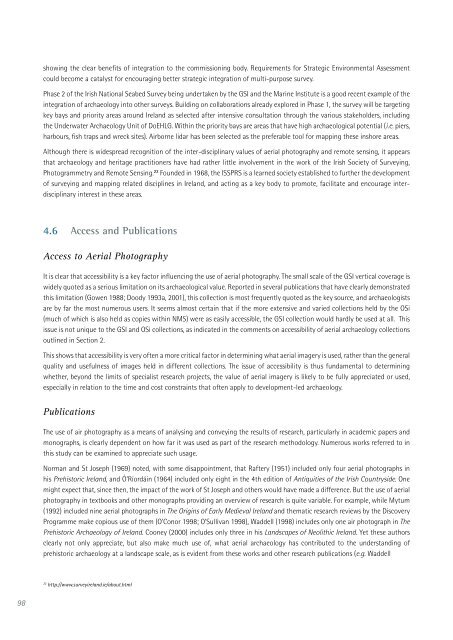Aerial Archaeology in Ireland - The Heritage Council
Aerial Archaeology in Ireland - The Heritage Council
Aerial Archaeology in Ireland - The Heritage Council
You also want an ePaper? Increase the reach of your titles
YUMPU automatically turns print PDFs into web optimized ePapers that Google loves.
98<br />
show<strong>in</strong>g the clear benefits of <strong>in</strong>tegration to the commission<strong>in</strong>g body. Requirements for Strategic Environmental Assessment<br />
could become a catalyst for encourag<strong>in</strong>g better strategic <strong>in</strong>tegration of multi-purpose survey.<br />
Phase 2 of the Irish National Seabed Survey be<strong>in</strong>g undertaken by the GSI and the Mar<strong>in</strong>e Institute is a good recent example of the<br />
<strong>in</strong>tegration of archaeology <strong>in</strong>to other surveys. Build<strong>in</strong>g on collaborations already explored <strong>in</strong> Phase 1, the survey will be target<strong>in</strong>g<br />
key bays and priority areas around <strong>Ireland</strong> as selected after <strong>in</strong>tensive consultation through the various stakeholders, <strong>in</strong>clud<strong>in</strong>g<br />
the Underwater <strong>Archaeology</strong> Unit of DoEHLG. With<strong>in</strong> the priority bays are areas that have high archaeological potential (i.e. piers,<br />
harbours, fish traps and wreck sites). Airborne lidar has been selected as the preferable tool for mapp<strong>in</strong>g these <strong>in</strong>shore areas.<br />
Although there is widespread recognition of the <strong>in</strong>ter-discipl<strong>in</strong>ary values of aerial photography and remote sens<strong>in</strong>g, it appears<br />
that archaeology and heritage practitioners have had rather little <strong>in</strong>volvement <strong>in</strong> the work of the Irish Society of Survey<strong>in</strong>g,<br />
Photogrammetry and Remote Sens<strong>in</strong>g. 22 Founded <strong>in</strong> 1968, the ISSPRS is a learned society established to further the development<br />
of survey<strong>in</strong>g and mapp<strong>in</strong>g related discipl<strong>in</strong>es <strong>in</strong> <strong>Ireland</strong>, and act<strong>in</strong>g as a key body to promote, facilitate and encourage <strong>in</strong>terdiscipl<strong>in</strong>ary<br />
<strong>in</strong>terest <strong>in</strong> these areas.<br />
4.6 Access and Publications<br />
Access to <strong>Aerial</strong> Photography<br />
It is clear that accessibility is a key factor <strong>in</strong>fluenc<strong>in</strong>g the use of aerial photography. <strong>The</strong> small scale of the GSI vertical coverage is<br />
widely quoted as a serious limitation on its archaeological value. Reported <strong>in</strong> several publications that have clearly demonstrated<br />
this limitation (Gowen 1988; Doody 1993a, 2001), this collection is most frequently quoted as the key source, and archaeologists<br />
are by far the most numerous users. It seems almost certa<strong>in</strong> that if the more extensive and varied collections held by the OSi<br />
(much of which is also held as copies with<strong>in</strong> NMS) were as easily accessible, the GSI collection would hardly be used at all. This<br />
issue is not unique to the GSI and OSi collections, as <strong>in</strong>dicated <strong>in</strong> the comments on accessibility of aerial archaeology collections<br />
outl<strong>in</strong>ed <strong>in</strong> Section 2.<br />
This shows that accessibility is very often a more critical factor <strong>in</strong> determ<strong>in</strong><strong>in</strong>g what aerial imagery is used, rather than the general<br />
quality and usefulness of images held <strong>in</strong> different collections. <strong>The</strong> issue of accessibility is thus fundamental to determ<strong>in</strong><strong>in</strong>g<br />
whether, beyond the limits of specialist research projects, the value of aerial imagery is likely to be fully appreciated or used,<br />
especially <strong>in</strong> relation to the time and cost constra<strong>in</strong>ts that often apply to development-led archaeology.<br />
Publications<br />
<strong>The</strong> use of air photography as a means of analys<strong>in</strong>g and convey<strong>in</strong>g the results of research, particularly <strong>in</strong> academic papers and<br />
monographs, is clearly dependent on how far it was used as part of the research methodology. Numerous works referred to <strong>in</strong><br />
this study can be exam<strong>in</strong>ed to appreciate such usage.<br />
Norman and St Joseph (1969) noted, with some disappo<strong>in</strong>tment, that Raftery (1951) <strong>in</strong>cluded only four aerial photographs <strong>in</strong><br />
his Prehistoric <strong>Ireland</strong>, and Ó’Ríordá<strong>in</strong> (1964) <strong>in</strong>cluded only eight <strong>in</strong> the 4th edition of Antiquities of the Irish Countryside. One<br />
might expect that, s<strong>in</strong>ce then, the impact of the work of St Joseph and others would have made a difference. But the use of aerial<br />
photography <strong>in</strong> textbooks and other monographs provid<strong>in</strong>g an overview of research is quite variable. For example, while Mytum<br />
(1992) <strong>in</strong>cluded n<strong>in</strong>e aerial photographs <strong>in</strong> <strong>The</strong> Orig<strong>in</strong>s of Early Medieval <strong>Ireland</strong> and thematic research reviews by the Discovery<br />
Programme make copious use of them (O’Conor 1998; O’Sullivan 1998), Waddell (1998) <strong>in</strong>cludes only one air photograph <strong>in</strong> <strong>The</strong><br />
Prehistoric <strong>Archaeology</strong> of <strong>Ireland</strong>. Cooney (2000) <strong>in</strong>cludes only three <strong>in</strong> his Landscapes of Neolithic <strong>Ireland</strong>. Yet these authors<br />
clearly not only appreciate, but also make much use of, what aerial archaeology has contributed to the understand<strong>in</strong>g of<br />
prehistoric archaeology at a landscape scale, as is evident from these works and other research publications (e.g. Waddell<br />
22 http://www.surveyireland.ie/about.html

















